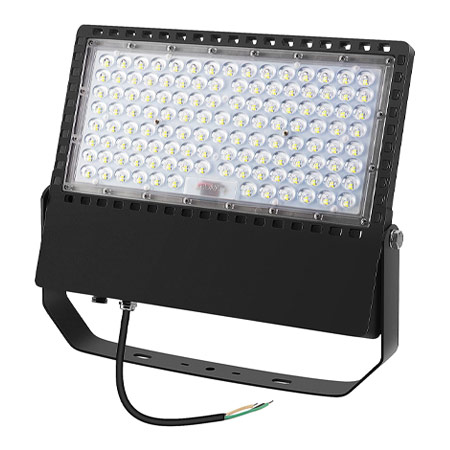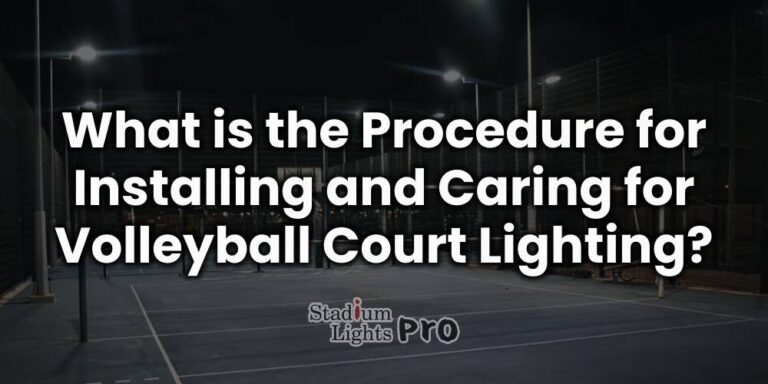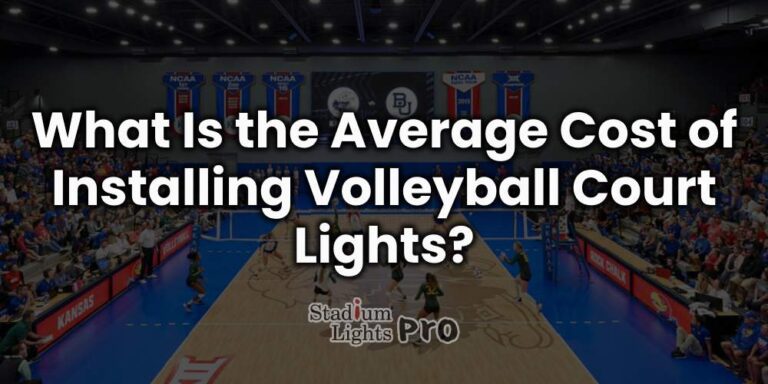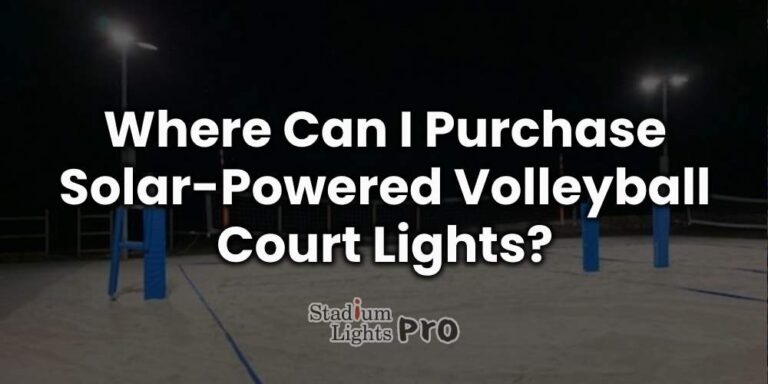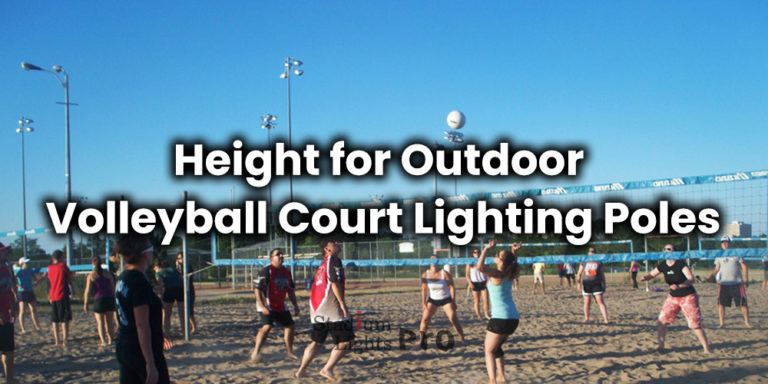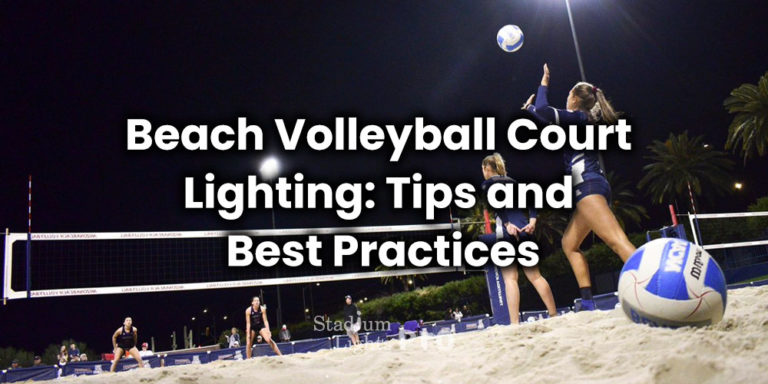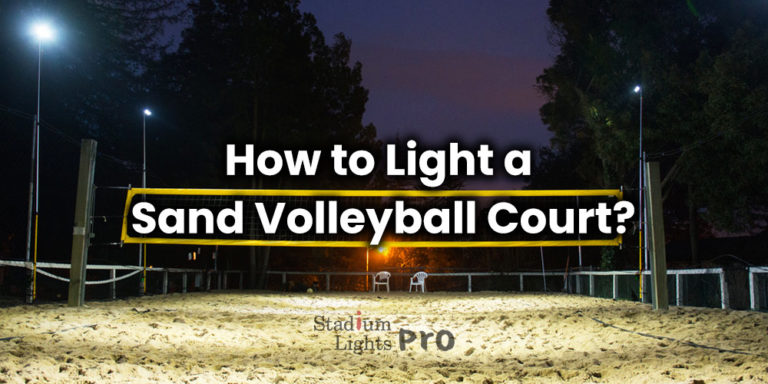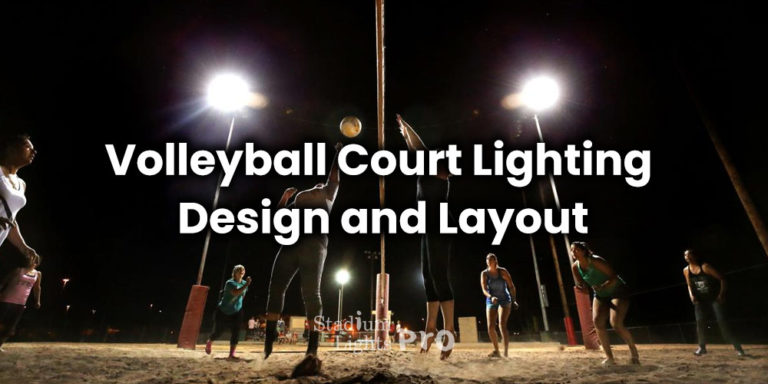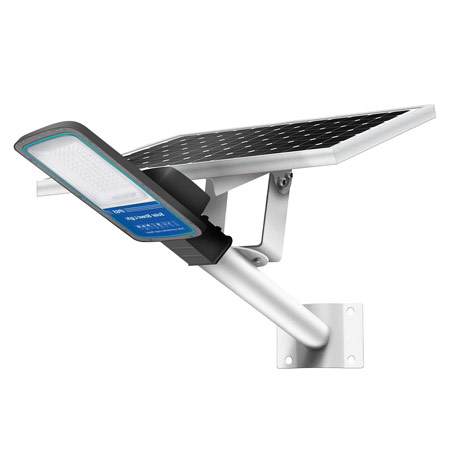
Volleyball Court Lighting
Welcome to our page on volleyball court lighting! If you’re responsible for designing, installing, or maintaining lighting for a volleyball court, you know that proper lighting is crucial for the safety and enjoyment of players and spectators. In this page, you’ll find a wealth of information on the various factors to consider when selecting and installing lighting for a volleyball court.
We’ll cover everything from the minimum lighting standards set by governing bodies to the advantages and disadvantages of different lighting technologies.
Whether you’re building a new court or upgrading the lighting in an existing facility, you’ll find valuable insights and tips on this page. So grab a cup of coffee, pull up a chair, and let’s dive into the exciting world of volleyball court lighting!
Contact us for a free lighting consultation
Table of Contents
ToggleVolleyball court lights frequently asked questions
What is the minimum lighting level for a volleyball court?
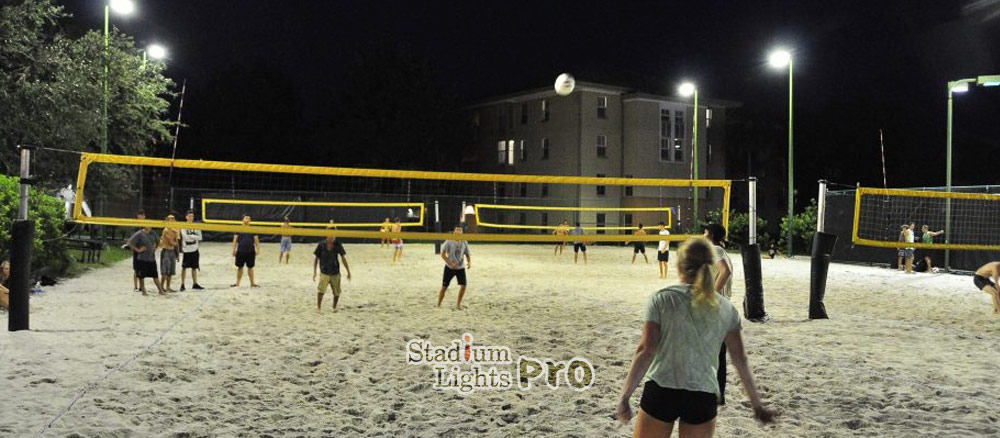
The minimum lighting level for a volleyball court may vary depending on the specific requirements of the facility or venue and the governing body that sets the standards. For example, the International Volleyball Federation (FIVB) recommends a minimum illumination level of 500 lux on the playing surface and around the perimeter of the court, while the National Collegiate Athletic Association (NCAA) recommends a minimum illumination level of 300-500 lux on the playing surface, depending on the level of competition.
What are the advantages of LED lighting for a volleyball court?
LED lighting has several advantages for use in a volleyball court. LED lights are energy-efficient, which can result in cost savings over the long term. They also have a long lifespan and are generally more durable than other types of lighting. LED lights can also be dimmed or controlled remotely, which can be useful for adjusting the lighting levels for different events or activities.
What are the disadvantages of LED lighting for a volleyball court?
One potential drawback of LED lighting for a volleyball court is the initial cost. LED lights may be more expensive to purchase and install compared to other types of lighting. However, the long-term energy savings and other benefits of LED lighting may make it a worthwhile investment.
What are some factors to consider when designing and installing lighting for a volleyball court?
There are several factors to consider when designing and installing lighting for a volleyball court, including the type and placement of lighting fixtures, the height of the fixtures above the court, the intensity and uniformity of the light on the court, and the color temperature of the lights.
We need to evaluate the specific needs of the court and choose a lighting system that meets those needs while also being energy-efficient and cost-effective.
How often should the lighting on a volleyball court be replaced?
The lifespan of the lighting on a volleyball court will depend on the specific type of lighting used and the conditions in which it is used. In general, LED lights have a longer lifespan compared to other types of lighting, with an expected lifespan of around 100,000 hours or more.
Fluorescent lights may have a shorter lifespan, with an expected lifespan of around 15,000-25,000 hours. It’s a good idea to consult the manufacturer’s recommendations for the specific type of lighting used on the court and plan for regular maintenance and replacement as needed.
What is the impact of lighting on the energy consumption of a volleyball court?
Lighting can have a significant impact on the energy consumption of a volleyball court. Energy-efficient lighting options, such as LED lights, can help to reduce energy consumption and costs. We also need to consider the intensity and uniformity of the lighting, as well as the placement and number of fixtures used.
Properly designed and installed lighting can help to minimize energy consumption while still providing good visibility for players and spectators.
Can the lighting on a volleyball court be controlled remotely?
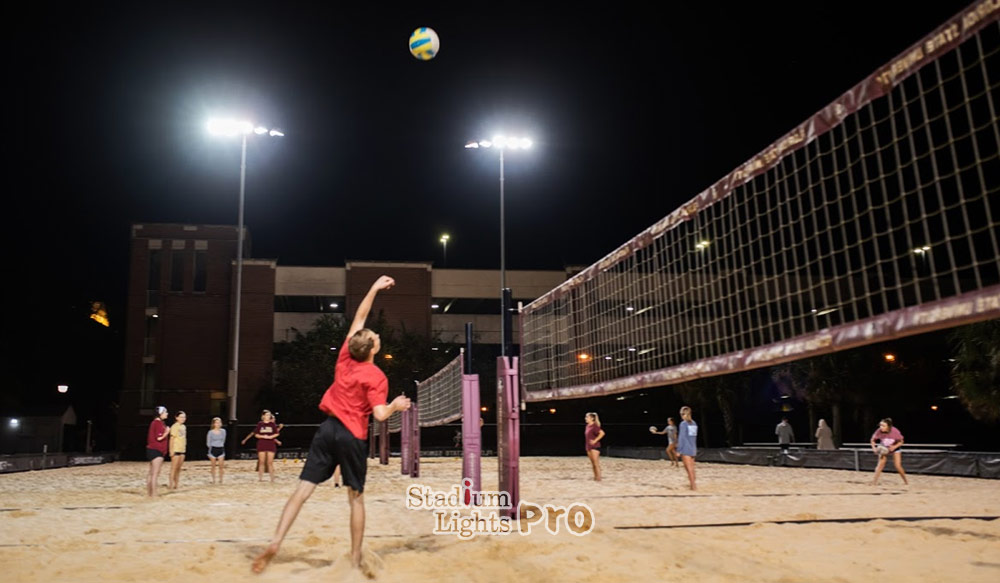
Yes, some types of lighting for a volleyball court can be controlled remotely. For example, LED lights can often be dimmed or turned on and off remotely using a control system.
This can be useful for adjusting the lighting levels for different events or activities, or for controlling energy consumption. It’s suggested to choose lighting fixtures and control systems that are compatible with each other and meet the specific needs of the court.
Is it possible to retrofit an existing volleyball court with new lighting?
Yes, it is possible to retrofit an existing volleyball court with new lighting. This may involve replacing the existing lighting fixtures with new ones or adding additional fixtures to improve the visibility and energy efficiency of the court.
Retrofitting an existing court with new lighting may require the services of a lighting professional or electrician.
Can natural light be used to supplement the lighting on a volleyball court?
Yes, natural light can be used to supplement the lighting on a volleyball court, particularly for outdoor courts. Natural light can provide good visibility and can help to reduce energy consumption by reducing the need for artificial lighting.
However, natural light alone may not be sufficient for all times of the day or in all weather conditions, so it’s essential to also have a reliable artificial lighting system in place.
What are the maintenance requirements for lighting on a volleyball court?
The maintenance requirements for lighting on a volleyball court will depend on the specific type of lighting used and the conditions in which it is used.
LED lights may require less maintenance compared to other types of lighting due to their long lifespan and durability. However, all lighting systems will require regular cleaning and maintenance to ensure that they are functioning properly and efficiently.
Can lighting be used to create a unique or memorable atmosphere on a volleyball court?
Yes, lighting can be used to create a unique or memorable atmosphere on a volleyball court. For example, dynamic or color-changing lighting systems can be used to create a visually interesting or exciting atmosphere for players and spectators.
Lighting can also be used to highlight specific areas of the court or to create a specific mood or ambiance. It’s recommended to consider the desired atmosphere and choose a lighting system that is suitable for the specific needs of the court.
Are there any safety concerns to consider when designing and installing lighting for a volleyball court?
Yes, there are safety concerns to consider when designing and installing lighting for a volleyball court. It’s necessary to ensure that the lighting system is properly installed and maintained to minimize the risk of electrical hazards or equipment failure.
We also need to take a look at the impact of the lighting on players and spectators, including the potential for glare or other visual distractions. It’s a good idea to consult with a lighting professional or electrician to ensure that the lighting system meets all applicable safety standards and guidelines.
What are the volleyball court lighting standards?
The International Volleyball Federation (FIVB) recommends a minimum illumination level of 500 lux on the playing surface and around the perimeter of the court.
The National Collegiate Athletic Association (NCAA) recommends a minimum illumination level of 300-500 lux on the playing surface, depending on the level of competition (e.g. 300 lux for high school, 400 lux for collegiate, 500 lux for international).
The National Federation of State High School Associations (NFHS) recommends a minimum illumination level of 300-500 lux on the playing surface, depending on the level of competition (e.g. 300 lux for regular season, 400 lux for post-season, 500 lux for televised events).
These are just minimum standards, and many facilities choose to exceed these standards to provide even better visibility for players and spectators. The specific lighting requirements may also vary depending on the specific requirements of the facility or venue.
How to light a volleyball court?
Type and placement of lighting fixtures
The type and placement of lighting fixtures can have a big impact on the visibility and energy efficiency of a volleyball court. Different types of fixtures, such as LED, HID, and fluorescent, have different advantages and disadvantages. Fixtures should be placed in a way that provides even illumination across the entire court, without creating shadows or glare.
Height of fixtures above the court
The height of the fixtures above the court can also affect the visibility and energy efficiency of the court. Generally, higher fixtures will provide better visibility, but may also require more energy. Lower fixtures may be more energy-efficient, but may also create shadows or cause glare.
Intensity and uniformity of light on the court
The intensity and uniformity of the light on the court are also essential considerations. Higher intensity light will provide better visibility, but may also be more energy-intensive. We need to strike a balance between intensity and energy efficiency. The light on the court should be evenly distributed, with no areas of excessive or insufficient illumination.
Color temperature of the lights
It is recommended to use lighting with a color temperature of around 3500-4000 K for indoor volleyball courts. This range of color temperatures is considered to be neutral and provides good color rendering, which means that the colors of objects on the court will appear as they would under natural sunlight.
Lighting with a lower color temperature (e.g. 2700 K) may appear warmer and more yellow, while lighting with a higher color temperature (e.g. 5000 K or higher) may appear cooler and more blue. The choice of color temperature may depend on the specific needs and preferences of the facility or venue.
Successful volleyball court lighting projects
The Richmond Olympic Oval in Vancouver
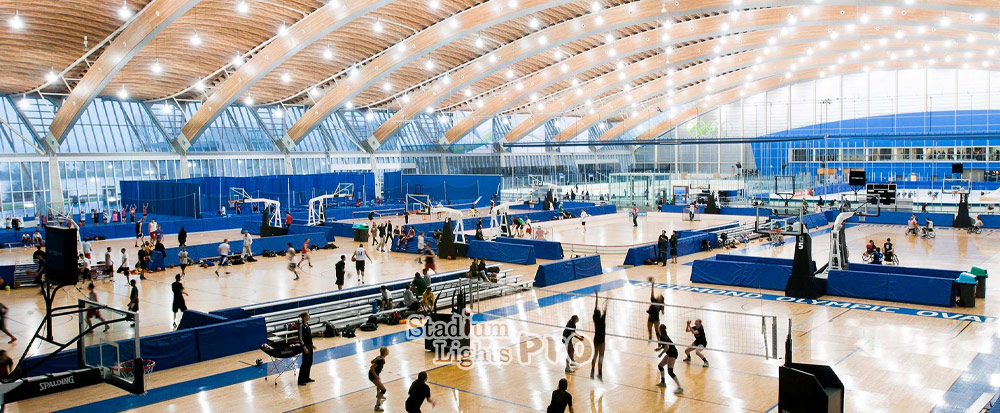
The Richmond Olympic Oval in Vancouver is a multi-sport facility that was used as a venue for the 2010 Winter Olympics. It features a variety of indoor sports courts, including courts for volleyball.
In 2009, the facility installed LED lighting for its indoor volleyball courts as part of a larger energy efficiency upgrade project. The new LED lighting system improved visibility and reduced energy consumption compared to the previous fluorescent lighting.
The facility has continued to use LED lighting for its volleyball courts since the 2010 Olympics. The Richmond Olympic Oval is just one example of a successful volleyball court lighting project that has made use of LED technology.
The University of Colorado Boulder
The University of Colorado Boulder is a public research university located in Boulder, Colorado. In 2017, the university upgraded the lighting in its indoor volleyball arena, the Coors Events Center, to LED.
The City of Mississauga in Ontario
The City of Mississauga is a city in Ontario, Canada, located on the shores of Lake Ontario. The city has a number of outdoor beach volleyball courts at Lakefront Promenade Park, which are popular with local residents and visitors.
In recent years, the city has installed LED lighting for these courts to improve visibility and allow for extended hours of play. The new LED lighting system has been well received by players and has helped to increase the popularity of the courts.
The University of Texas at Austin
The University of Texas at Austin is a public research university located in Austin, Texas. In recent years, the university has installed LED lighting for its indoor volleyball courts in the Gregory Gymnasium.
Get a free volleyball court lighting design from us
If you’d like to receive a free lighting design for your outdoor or indoor volleyball court, please don’t hesitate to contact us.
We have a team of lighting experts who are knowledgeable in the specific requirements and considerations for lighting in volleyball courts. We’d be happy to provide a custom lighting design tailored to your specific needs and preferences, completely free of charge. Simply reach out to us and we’ll be glad to assist you.

